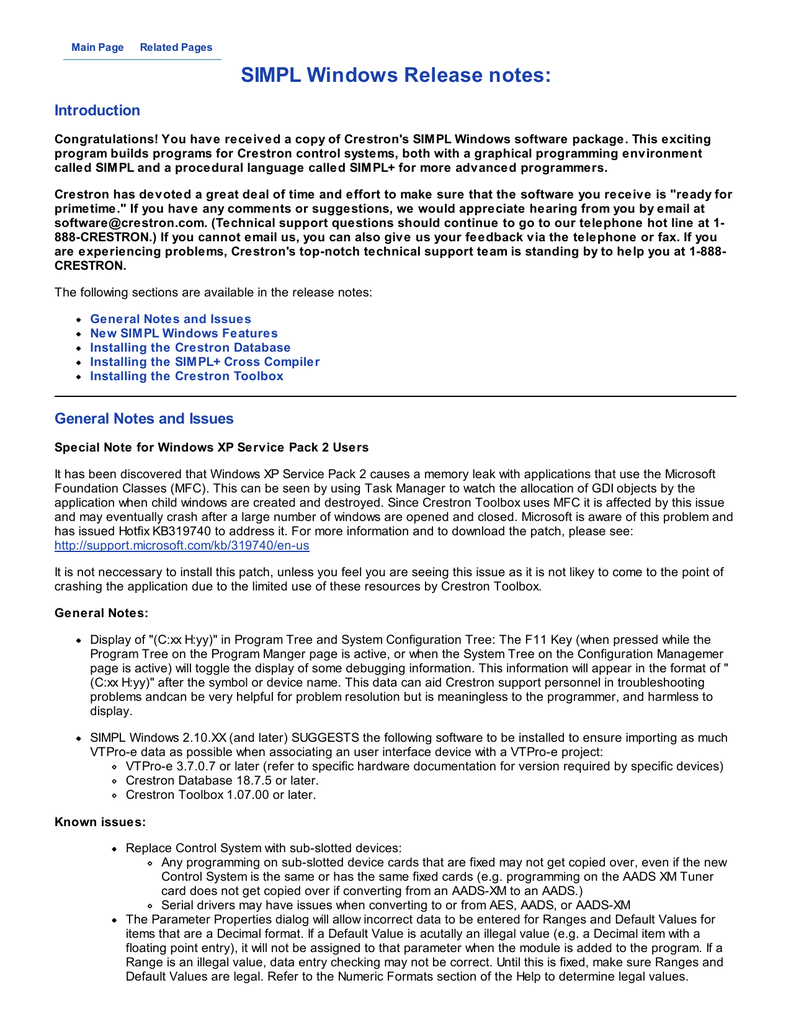

- #Crestron simpl volume string drivers#
- #Crestron simpl volume string driver#
The control system must be rebooted from the Crestron Home Setup UI when reimporting a driver. NOTE: Do not issue the reboot console command to reboot the control system.
From the Crestron Home Setup UI, navigate to Settings > System Configuration > Reboot, and then select Reboot to reboot the control system. #Crestron simpl volume string driver#
Remove all instances of the old driver from Crestron Home. If you make changes to your driver and want to reimport the new driver, you must first follow these steps to erase the old driver: #Crestron simpl volume string drivers#
NOTE: The custom driver will overwrite existing drivers on the Crestron Home processor if the drivers share the same ID (manufacturer, model name, and communication type) Reimport a Driver Once the transfer is complete, a pop‑up dialog is displayed showing the package file, the device hostname/IP address, and the transfer status.
Select the Crestron Home processor using the Address Book tool and then click OK. Save the driver package file to the User Database. Open the Device Learner tool in Crestron Toolbox™ software. The screen refreshes automatically to display the driver after it has been loaded into the system. Navigate to the driver using the Third Party Devices menu in the Pair Devices screen.  Upload the custom driver package file or IR file into the Crestron Home processor's \User\ThirdPartyDrivers\Import directory. Connect to the Crestron Home processor over FTP or by using the File Manager tool in Crestron Toolbox. Custom drivers can be loaded using FTP or the Device Learner tool (IR drivers only). Almost anything that can be programmed in SIMPL+ can be written in SIMPL.Device drivers should be side loaded into the control system running Crestron Home prior to adding the corresponding devices to the system. * SIMPL is a Turing-complete language except for its ephemeral strings and its limit on logic solutions exceding 1,000 logic waves. In my very first Crestron tech support call as an Essentials-level programmer, I was chastised by Rich Sasson for using the Clock Driver symbol, a technique taught to me in Essentials training not two months before. The Clock Driver symbol has the unfortunate side effect of continuously syncing the clocks of Cresnet touchpanels, which generates huge amounts of Cresnet traffic on systems with many Cresnet touchpanels. p serves as a replacement for the Clock Driver symbol. The other SIMPL+ modules in Crescendo are similarly low-activity and used for string parsing-with the exception of p, which is a necessary evil and actually runs an infinite loop.
Upload the custom driver package file or IR file into the Crestron Home processor's \User\ThirdPartyDrivers\Import directory. Connect to the Crestron Home processor over FTP or by using the File Manager tool in Crestron Toolbox. Custom drivers can be loaded using FTP or the Device Learner tool (IR drivers only). Almost anything that can be programmed in SIMPL+ can be written in SIMPL.Device drivers should be side loaded into the control system running Crestron Home prior to adding the corresponding devices to the system. * SIMPL is a Turing-complete language except for its ephemeral strings and its limit on logic solutions exceding 1,000 logic waves. In my very first Crestron tech support call as an Essentials-level programmer, I was chastised by Rich Sasson for using the Clock Driver symbol, a technique taught to me in Essentials training not two months before. The Clock Driver symbol has the unfortunate side effect of continuously syncing the clocks of Cresnet touchpanels, which generates huge amounts of Cresnet traffic on systems with many Cresnet touchpanels. p serves as a replacement for the Clock Driver symbol. The other SIMPL+ modules in Crescendo are similarly low-activity and used for string parsing-with the exception of p, which is a necessary evil and actually runs an infinite loop. 
Both modules are also low activity: p only executes upon an input switch, Menu p only executes upon a menu selection or interface context change. Menu p is a complex conditional (provide a navigable menu given an interface context and a set of meta signals). p is a string parsing module (find the first instance of a character in a string array and return the index). In both cases, creating SIMPL-only versions of these modules would be possible, * but their implementations require hundreds or thousands of symbols. The Crescendo Framework core modules only have two SIMPL+ dependencies: Switcher.umc requires p and Menu Controller.umc requires Menu p. In a future post, I will rewrite the module using only SIMPL and demonstrate that it is feature-identical (actually feature-superior) to the SIMPL+ version. The entire purpose of the house volume module was analog ramping, and the module replaced a few hundred symbols with a bulky, preemptible while loop. (Similarly, never use SIMPL realtime symbols such as a One Shot when symbols such as a Logic Wave Pulse will suffice.) Specifically, avoid the use of PULSE, WAIT, and DELAY in SIMPL+. Specifically, never let SIMPL+ input a ramp control block, process it, and output a discrete value.
Prefer SIMPL+ for complex conditionals. The general rule for using SIMPL+ is: Use SIMPL+ where one module can replace thousands of SIMPL symbols. The module could have been programmed entirely in SIMPL, and it should have been programmed entirely in SIMPL. My previous post on SIMPL+ array bounds checks avoided the broader question of the appropriateness of SIMPL+ for a house volume module in the first place.







 0 kommentar(er)
0 kommentar(er)
